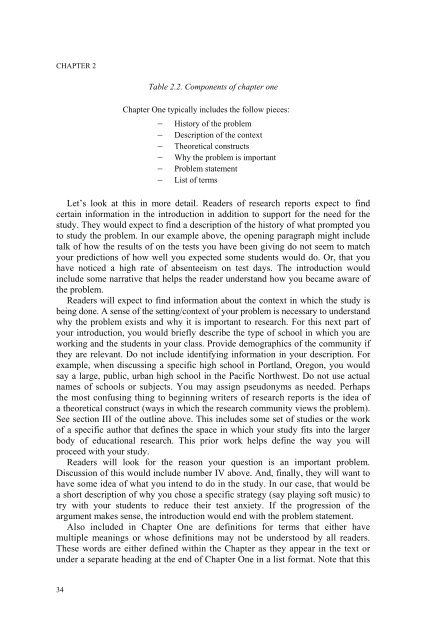Conducting Educational Research
Caroll
Caroll
You also want an ePaper? Increase the reach of your titles
YUMPU automatically turns print PDFs into web optimized ePapers that Google loves.
CHAPTER 2<br />
34<br />
Table 2.2. Components of chapter one<br />
Chapter One typically includes the follow pieces:<br />
− History of the problem<br />
− Description of the context<br />
− Theoretical constructs<br />
− Why the problem is important<br />
− Problem statement<br />
− List of terms<br />
Let’s look at this in more detail. Readers of research reports expect to find<br />
certain information in the introduction in addition to support for the need for the<br />
study. They would expect to find a description of the history of what prompted you<br />
to study the problem. In our example above, the opening paragraph might include<br />
talk of how the results of on the tests you have been giving do not seem to match<br />
your predictions of how well you expected some students would do. Or, that you<br />
have noticed a high rate of absenteeism on test days. The introduction would<br />
include some narrative that helps the reader understand how you became aware of<br />
the problem.<br />
Readers will expect to find information about the context in which the study is<br />
being done. A sense of the setting/context of your problem is necessary to understand<br />
why the problem exists and why it is important to research. For this next part of<br />
your introduction, you would briefly describe the type of school in which you are<br />
working and the students in your class. Provide demographics of the community if<br />
they are relevant. Do not include identifying information in your description. For<br />
example, when discussing a specific high school in Portland, Oregon, you would<br />
say a large, public, urban high school in the Pacific Northwest. Do not use actual<br />
names of schools or subjects. You may assign pseudonyms as needed. Perhaps<br />
the most confusing thing to beginning writers of research reports is the idea of<br />
a theoretical construct (ways in which the research community views the problem).<br />
See section III of the outline above. This includes some set of studies or the work<br />
of a specific author that defines the space in which your study fits into the larger<br />
body of educational research. This prior work helps define the way you will<br />
proceed with your study.<br />
Readers will look for the reason your question is an important problem.<br />
Discussion of this would include number IV above. And, finally, they will want to<br />
have some idea of what you intend to do in the study. In our case, that would be<br />
a short description of why you chose a specific strategy (say playing soft music) to<br />
try with your students to reduce their test anxiety. If the progression of the<br />
argument makes sense, the introduction would end with the problem statement.<br />
Also included in Chapter One are definitions for terms that either have<br />
multiple meanings or whose definitions may not be understood by all readers.<br />
These words are either defined within the Chapter as they appear in the text or<br />
under a separate heading at the end of Chapter One in a list format. Note that this



